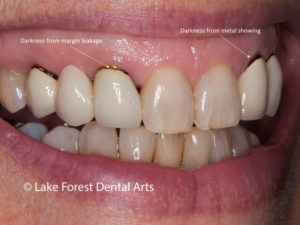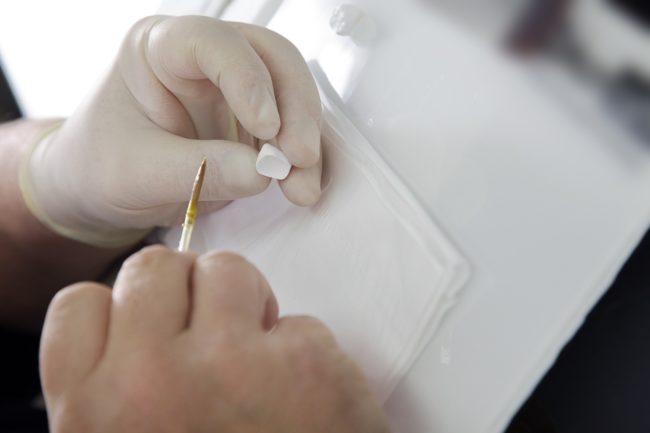
The metal under a crown is showing
Problem: The metal under a crown is showing. It appears like a black line where the gum meets the tooth. “That tooth looks completely fake now, and I’m embarrassed when people see it. I’ve started to intentionally not open my mouth wide in public. Help!”
Solution: It sounds like you’re dealing with an aging restoration, specifically with a PFM dental crown. You can have the issue corrected by getting a new restoration. Unfortunately, the cap in your mouth now cannot be whitened or refreshed to look like it did when it was new.
No one wants fake looking teeth, so in this article, you’ll learn about:
- Crown material options and why the metal under your crown shows
- Benefits and drawbacks of each material
- How to find a dentist who can provide you with restorations that feature the best results and longevity.
Why does your crown have metal under it in the first place?
The majority of dental crowns made today have metal in them for strength. To get the benefits of metal’s strength and ceramic’s whiteness, porcelain is fused over the metal to make it attractive. The problem is, most dentists design PFMs so that the porcelain does not cover the metal at the edge. If the gums are thin or recede the dark metal becomes obvious. As the edge or margin becomes more exposed, a dark line may show up at the gum line.
Metal is a more durable material than ceramic, but ceramic looks like enamel. A shade guide is used to match it to the teeth that will reside on either side of a new restoration. The result is a seamless restoration, meaning that the new crown looks just like a natural tooth.
What else causes darkness at the gumline?
The restoration may be leaking. The cement that holds your restoration on is similar to tile grout. It is normally protected by the gums covering the margin. As the gums recede, the margin becomes exposed. This cement begins to wash out. As the margin seal leaks, it accumulates stains. These stains can be very dark.
If the porcelain overlying your tooth is too thin, the dark tooth underneath will show through. This is especially common when the tooth has had a root canal or when the temporary crown causes recession.
Types of Crowns
There are many materials to choose from when designing restorations:
- PFMs – have metal under crown – usually base metal alloys
- Porcelain fused to gold – high noble alloys
- Dental implant – Zirconium is now used most frequently
- All porcelain or ceramic crowns used for front teeth
- Zirconia
- All-metal
- Gold (precious metal)
The material selected depends upon the patient’s goals and where the restoration will be located in the mouth. The cost of the crowns will also depend on the quality niche the dentist practices at. Generally, a front tooth crown is well served with all porcelain caps. Teeth that require more strength do well with PFMs. Both of these types of restorations are tooth colored, so the patient’s smile will retain its white beauty.
Back teeth, which have to endure 700 pounds of pressure per square inch when chewing, require a strong, sturdy material. Zirconia and only metal versions are preferred for back teeth. However, metal is dark and/or metallic, so it stands out against white, natural teeth.
Some people don’t mind having metallic restorations (like stainless steel crowns or gold alloy) on molars because they don’t show in the person’s smile. However, to maintain a natural looking set of teeth throughout the mouth, zirconia provides durability similar to metal. But zirconia is white and reflective, so it looks like tooth enamel.
Are there alternatives for strong crowns for molars, besides those with metal?
Absolutely! There are two specific ways to create a strong dental restoration that does not reveal dark metal. One has to do with how a porcelain fused to metal crown is designed, the other is an alternative material.
The potential for dark margins can be reduced by:
- Using better quality porcelain and extending the porcelain to the margin
- Using zirconia which is not metallic
What happens if the metal under crowns unseals from the natural tooth below?
Over time, all permanent crowns will degrade. Dental restorations can be designed to last a long time. However, no dental restoration will last forever. In most cases,
- PFM crowns last 10 years esthetically and 20 years functionally
- All-porcelain crowns last an average of 15 years
- Metallic caps last an average of 15 years
- Zirconia crowns can last a lifetime depending on fit
- Gold crowns can last a lifetime and they are kinder to the opposing teeth
If you have a toothache on a crowned tooth or suspect that a restoration is failing, have it checked immediately. A broken seal allows bacteria to infiltrate the tooth beneath the restoration. This can cause hidden cavities, which may grow rapidly in the dark, moist environment between the margin and the underlying tooth.
Left untreated, cavities beneath crowns can penetrate deep into a tooth, hurting the root. When this happens, the tooth may need a root canal or, in some cases, the tooth may require removal.
 The dental ceramist’s job
The dental ceramist’s job
The best cosmetic dentists tend to partner with the best ceramists. They are technicians who work in a dental lab. The best ones work with better and prettier porcelains and the highest quality dental materials. They have years of experience, in which time they’ve perfected the craft of layering ceramic so that looks tooth enamel.
Once a cosmetic dentist finds a ceramist to partner with, the team can offer gorgeous restorations to patients. You should know that when it comes to restorations, you will pay more for a great product. A master ceramist will invest in quality materials and spend more time making a restoration.
For cheaper restorations, overseas dental labs are used. Many countries have unregulated labs that use unsafe alloys and shortcut techniques. Chinese made crowns have been known to have harmful effects. With that said, some overseas dental labs are world renowned. Ask your dentist about the lab and ceramist he will use for your crown. If you don’t trust your dentist to work with a quality lab, then you may need to keep searching for a new office.
How to find a practitioner who can mask obvious metal under a crown
For excellent looks in a dental crown and optimal life span, you need a talented, respected cosmetic dentist. It’s important to trust your dentist with your smile and oral health.
Training
The training a dentist has greatly impacts the dental work he provides. Look for one with training that involves many continuing education hours and hands on courses. He or she will have the education to provide superior cosmetic smile makeovers. You should learn about a dentist’s training, experience, and other accolades on the about page of his or her website.
Experience and artistic talent
In addition, a dentist’s experience counts. When searching for a dentist who can deliver great crowns, you’ll learn a lot by exploring his or her before and after gallery. Hopefully, the gallery features actual cases the dentist completed and not purchased before and afters. If you look closely, you can see how natural the dentistry looks.
There are plenty of well trained experienced people who don’t have artistic skills. Artistic dentistry is more rare.
Reputation
Learn if patients respect a dentist by reading his or her patient stories. You may find patient testimonials on the dentist’s website. You can also just go to the Google Business page for a dentist or dental practice to see Google Reviews. Looking at Facebook may also provide insight into what patients think about a dentist.
Once you’ve found a great cosmetic dentist, schedule a meeting to discuss your issues. While you’re at it, you may want to explore options in teeth whitening, porcelain veneers, adult braces, gum contouring, bonding, or tooth reshaping. These treatments are usually combined in a smile makeover plan to give you your ideal smile.
Market niche
Usually, a dentist offering a good service for a good price will not hide the metal under their crowns. The lab bill will be too big for the market niche.
Dr. James Fondriest has spent years developing his skill as a cosmetic dentist, as well as his eye for esthetics. He offers comprehensive restorative dental care. Dr. Fondriest is also known in professional circles as a speaker, educator, and author.
In addition to his extensive education, training, and experience in cosmetic and restorative dentistry, he’s a photographer. All of the images on his website were taken by him. If you look at these photographs, you will notice his talent and eye for detail.
Dr. Fondriest is a Nationally recognized and highly sought after cosmetic dentist. He serves clients from throughout the United States

 The dental ceramist’s job
The dental ceramist’s job